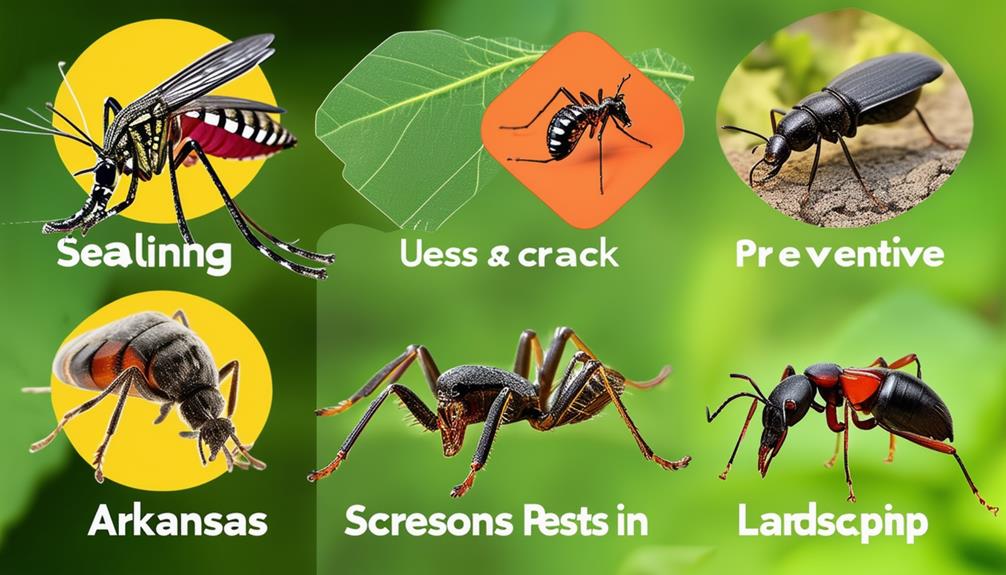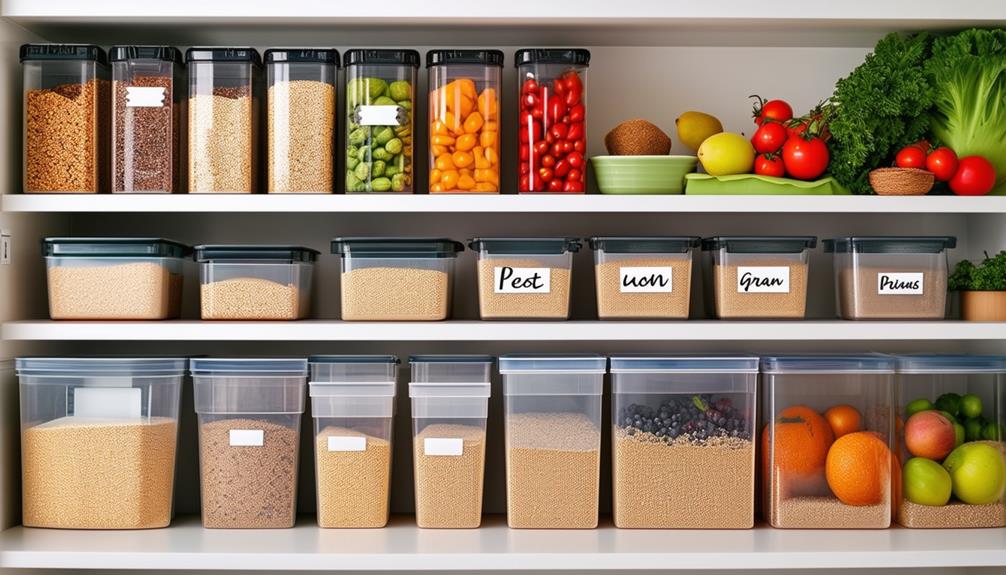When faced with a pest infestation in your Arkansas food service area, swift action is paramount. Identifying the signs of pests is just the beginning. By implementing thorough measures like removing food sources, blocking entrances, and maintaining cleanliness, you lay the foundation for effective pest control. However, the key lies not only in reacting but also in preventing future infestations. Stay tuned to discover the detailed strategies and best practices to safeguard your food service establishment in Arkansas.
Key Takeaways
- Implement Integrated Pest Management (IPM) strategies.
- Regularly monitor for pest activity and signs.
- Work with licensed pest control professionals.
- Follow Arkansas health department regulations.
Identifying Pest Infestation Signs
How can you accurately identify signs of a pest infestation in food service areas in Arkansas?
Detecting pests early is essential for effective pest control. When it comes to rodents, look for droppings, gnaw marks on packaging, and nests in dark corners.
For cockroaches, keep an eye out for live or dead insects, egg casings, and shed skins near food sources.
Stored product pests can be identified by unusual odors, grease marks, and chewed packaging. Additionally, watch for fly sightings, larvae, and breeding sites to spot a potential fly infestation.
To detect pests early, monitor for activity during off-hours, inspect secluded areas, and listen for scratching sounds.
Removing Food Sources and Attractions
To effectively eliminate pests from food service areas in Arkansas, promptly remove all sources of food and attractions that may entice unwanted visitors. Begin by ensuring all kitchen surfaces are cleaned regularly to eliminate food residues that could attract pests like ants and cockroaches.
It’s vital to promptly eliminate crumbs and spills as these can serve as a food source for pests. Proper food storage is indispensable in preventing pest attraction and contamination; store food in sealed containers to deter bugs and rodents.
Additionally, reducing unnecessary lighting and using traps can help avoid attracting pests like cockroaches. By taking these measures, you can prevent food health violations that may arise from pest infestation, ensuring kitchen hygiene and food safety standards are met.
Blocking Pest Entrances
To effectively block pest entrances, seal any cracks and crevices with silicone or caulk.
Make sure to install screens and seals on doors and windows to prevent pests from finding their way in.
Regularly inspect and maintain door sweeps to guarantee they’re intact and functioning properly.
Seal Cracks Effectively
Effectively sealing cracks with silicone or caulk is important in blocking pest entrances to food service areas in Arkansas. By utilizing weather-stripping and door sweeps, you can further fortify these potential entryways against rodents and insects.
It’s necessary to also install screens on windows and vents to maintain proper ventilation while keeping pests out. Seal gaps around pipes and wiring using metal flashing to eliminate any additional entry points for pests.
Addressing and sealing all these potential entryways diligently is important in preventing pest infestations from taking root in your food service establishment. Be thorough in your approach to sealing cracks, as this simple yet effective measure can go a long way in safeguarding your premises against unwanted intruders.
Install Door Sweeps
Enhance your pest control measures and safeguard your premises by installing door sweeps, effective devices that seal gaps and block potential entrances for pests.
Door sweeps, which act as weather stripping at the bottom of doors, are essential in preventing pests like insects, rodents, and small animals from accessing your building in Arkansas.
By installing door sweeps, you not only keep pests out but also maintain temperature control, reduce energy costs, and improve indoor air quality. These devices also aid in noise reduction, enhancing the overall comfort of commercial buildings, restaurants, and homes.
Prioritizing the installation of door sweeps is a proactive step in fortifying your pest control strategies and protecting your establishment from unwanted intruders.
Keeping Dumpsters and Garbage Areas Clean
To maintain a pest-free environment, it’s essential to regularly clean and maintain dumpsters. Make sure to dispose of waste properly and avoid overflowing bins to deter pests.
Implement a routine of hosing down dumpsters, using liners, and disinfecting bins to prevent food residue buildup and keep pests at bay.
Regular Dumpster Maintenance
Regularly maintaining the cleanliness of dumpsters and garbage areas is essential in preventing pest infestations in Arkansas food service establishments. Dirty dumpsters attract larger pests like mice and rats due to food scraps and waste.
To combat this, regularly hose down the inside of dumpsters to keep them clean and reduce the risk of infestations. Using liners in garbage bins can prevent food buildup, making cleaning easier.
Make sure dumpster lids are kept shut and avoid overflowing dumpsters to deter pests from scavenging for food. Disinfecting garbage cans is vital if bags leak to maintain cleanliness and prevent pest attraction.
Proper Waste Disposal
To effectively maintain cleanliness and prevent pest infestation in Arkansas food service areas, proper waste disposal practices must be diligently implemented. When it comes to handling waste in food service areas, attention to detail is key. Here are some essential steps to keep dumpsters and garbage areas clean:
- Regularly hose down dumpsters: This helps eliminate food debris that attracts pests like mice and rats.
- Use liners in garbage bins: Prevent food buildup and reduce the risk of pest attraction in waste disposal areas.
- Keep dumpster lids shut and avoid overflow: Deter pests from scavenging for food, maintaining a clean environment.
Continual Kitchen Surface Cleaning
Implementing a consistent kitchen surface cleaning routine is essential in preventing pest infestations in Arkansas food service areas. Regularly wiping down kitchen surfaces throughout the day is important as it helps prevent the attraction of pests like cockroaches and flies.
By cleaning kitchen surfaces, you remove food debris that can serve as a food source for pests, thereby reducing the risk of infestation. Maintaining a clean kitchen environment is critical as it discourages pests from nesting or hiding in cracks and crevices on surfaces.
Continuous surface cleaning in the kitchen area is necessary for preventing contamination of food and ensuring food safety standards are met. Therefore, implementing a strict cleaning schedule for kitchen surfaces is crucial for minimizing the risk of pest infestations in food service areas.
Proper Food Storage Practices
How can you effectively maintain food quality and prevent pest contamination in food service areas through proper food storage practices? Proper food storage is essential for preventing pests, maintaining food safety, and passing inspections. Follow these guidelines to make certain your food storage practices are up to par:
- Store food off the floor: Keep food items elevated to deny pests easy access. Rodents and insects are less likely to contaminate food stored at higher levels.
- Utilize airtight containers: Seal food in airtight containers to maintain freshness and prevent contamination. This practice also helps in identifying any signs of pests early on.
- Follow the FIFO rule: Implement the First In, First Out rule to rotate food stock. This practice not only guarantees food safety by using older items first but also prevents spoilage that could attract pests.
Checking Deliveries for Pests
When receiving food deliveries in Arkansas food service areas, carefully scrutinize each shipment for any signs of pest presence to maintain food safety standards and prevent potential infestations. Inspecting deliveries for pests is a critical aspect of pest control in food service establishments. Pests can easily infiltrate shipments during transportation, emphasizing the importance of thorough checks. By verifying for pests, you not only uphold food safety standards but also prevent contamination and uphold food quality.
Regular inspection of deliveries is key to preventing infestations and avoiding the spread of bugs in the kitchen. Make it a habit to examine each delivery for any signs of pests, such as droppings, gnaw marks, or unusual odors. By being vigilant in checking for pests, you take proactive measures to safeguard the integrity of your food supply and protect your customers from potential health risks.
Frequently Asked Questions
How Can You Control Pests in a Foodservice Establishment?
To control pests in a foodservice establishment, you must be vigilant. Identify pests, implement sanitation practices, conduct regular inspections, practice pest exclusion, train employees, manage waste properly, monitor pests, use integrated pest management, and consider chemical treatments when necessary.
What Actions Should a Food Service Manager Take in Order to Prevent and Control Pests?
To prevent and control pests in food service areas, you should conduct regular pest inspections, maintain strict sanitation practices, implement pest-proofing measures, train employees, perform regular maintenance, use integrated pest management, guarantee proper waste disposal, use monitoring devices, and consider chemical treatments.
How Are Pests Reduced and Controlled in a Restaurant Facility?
In your restaurant, pests can be controlled and reduced by implementing integrated pest management techniques. Utilize sanitation practices, pest monitoring, exclusion methods, and employee training. Regular inspections, chemical treatments, and a focus on pest prevention guarantee effective pest elimination.
What Should You Do to Prevent a Pest Infestation of an Outdoor Dumpster Food Handler?
To prevent a pest infestation of an outdoor dumpster, you should conduct regular inspections, guarantee proper waste disposal, implement pest-proofing measures like sealing cracks, maintain effective sanitation, collaborate with professional extermination services, and monitor pests consistently.





